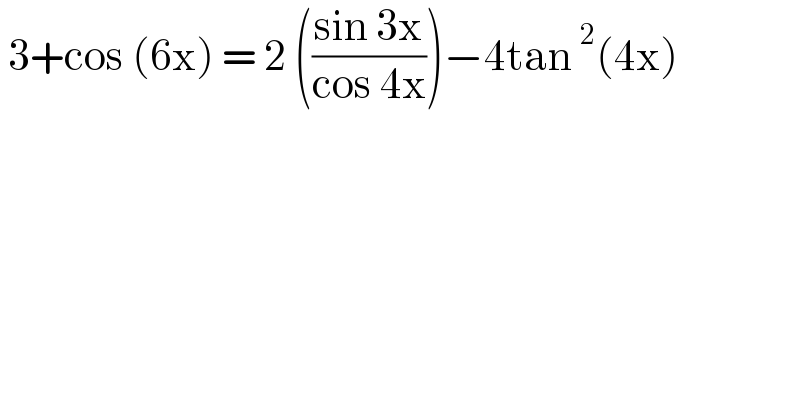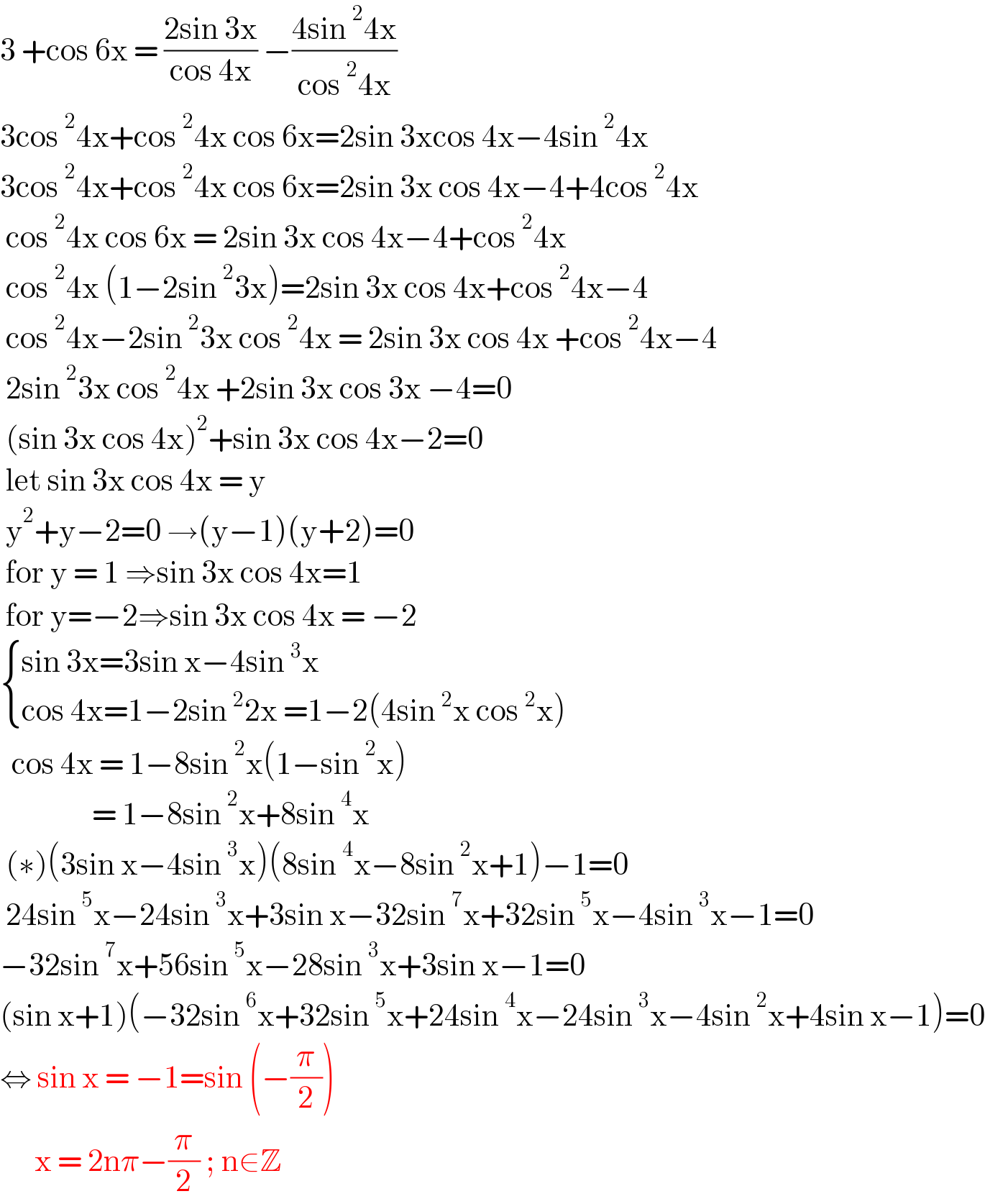Question Number 129958 by bemath last updated on 21/Jan/21

$$\:\mathrm{3}+\mathrm{cos}\:\left(\mathrm{6x}\right)\:=\:\mathrm{2}\:\left(\frac{\mathrm{sin}\:\mathrm{3x}}{\mathrm{cos}\:\mathrm{4x}}\right)−\mathrm{4tan}\:^{\mathrm{2}} \left(\mathrm{4x}\right) \\ $$
Answered by MJS_new last updated on 21/Jan/21

$${s}=\mathrm{sin}\:{x} \\ $$$$… \\ $$$${s}^{\mathrm{14}} −\frac{\mathrm{7}}{\mathrm{2}}{s}^{\mathrm{12}} +\frac{\mathrm{77}}{\mathrm{16}}{s}^{\mathrm{10}} −\frac{\mathrm{13}}{\mathrm{4}}{s}^{\mathrm{8}} −\frac{\mathrm{1}}{\mathrm{32}}{s}^{\mathrm{7}} +\frac{\mathrm{35}}{\mathrm{32}}{s}^{\mathrm{6}} +\frac{\mathrm{7}}{\mathrm{128}}{s}^{\mathrm{5}} −\frac{\mathrm{21}}{\mathrm{128}}{s}^{\mathrm{4}} −\frac{\mathrm{7}}{\mathrm{128}}{s}^{\mathrm{3}} +\frac{\mathrm{9}}{\mathrm{1024}}{s}^{\mathrm{2}} +\frac{\mathrm{3}}{\mathrm{1024}}{s}−\frac{\mathrm{1}}{\mathrm{512}}=\mathrm{0} \\ $$$$\mathrm{plotting}\:\mathrm{shows}\:\mathrm{the}\:\mathrm{only}\:\mathrm{solution}\:\mathrm{within}\:\mathrm{the} \\ $$$$\mathrm{interval}\:−\mathrm{1}\leqslant{s}\leqslant\mathrm{1}\:\mathrm{is}\:{s}=−\mathrm{1}\:\Leftrightarrow\:\mathrm{sin}\:{x}\:=−\mathrm{1} \\ $$$$\Rightarrow\:{x}=−\frac{\pi}{\mathrm{2}}+\mathrm{2}{n}\pi \\ $$
Commented by EDWIN88 last updated on 22/Jan/21

$$\mathrm{wrong}.\:\mathrm{it}\:\mathrm{should}\:\mathrm{be}\:\mathrm{sin}\:\mathrm{x}=\mathrm{1} \\ $$
Commented by MJS_new last updated on 22/Jan/21

$$\mathrm{no}.\:\mathrm{you}\:\mathrm{forgot}\:\mathrm{to}\:\mathrm{test}\:\mathrm{your}\:\mathrm{solution} \\ $$$$\mathrm{with}\:{x}=\frac{\pi}{\mathrm{2}}\:\mathrm{in}\:\mathrm{the}\:\mathrm{given}\:\mathrm{equation}\:\mathrm{you}\:\mathrm{get}\:\mathrm{2}=−\mathrm{2} \\ $$$$\mathrm{within}\:\mathrm{0}\leqslant{x}<\mathrm{2}\pi\:\mathrm{the}\:\mathrm{only}\:\mathrm{solution}\:\mathrm{is}\:\frac{\mathrm{3}\pi}{\mathrm{2}} \\ $$
Answered by EDWIN88 last updated on 22/Jan/21

$$\mathrm{3}\:+\mathrm{cos}\:\mathrm{6x}\:=\:\frac{\mathrm{2sin}\:\mathrm{3x}}{\mathrm{cos}\:\mathrm{4x}}\:−\frac{\mathrm{4sin}\:^{\mathrm{2}} \mathrm{4x}}{\mathrm{cos}\:^{\mathrm{2}} \mathrm{4x}} \\ $$$$\mathrm{3cos}\:^{\mathrm{2}} \mathrm{4x}+\mathrm{cos}\:^{\mathrm{2}} \mathrm{4x}\:\mathrm{cos}\:\mathrm{6x}=\mathrm{2sin}\:\mathrm{3xcos}\:\mathrm{4x}−\mathrm{4sin}\:^{\mathrm{2}} \mathrm{4x} \\ $$$$\mathrm{3cos}\:^{\mathrm{2}} \mathrm{4x}+\mathrm{cos}\:^{\mathrm{2}} \mathrm{4x}\:\mathrm{cos}\:\mathrm{6x}=\mathrm{2sin}\:\mathrm{3x}\:\mathrm{cos}\:\mathrm{4x}−\mathrm{4}+\mathrm{4cos}\:^{\mathrm{2}} \mathrm{4x} \\ $$$$\:\mathrm{cos}\:^{\mathrm{2}} \mathrm{4x}\:\mathrm{cos}\:\mathrm{6x}\:=\:\mathrm{2sin}\:\mathrm{3x}\:\mathrm{cos}\:\mathrm{4x}−\mathrm{4}+\mathrm{cos}\:^{\mathrm{2}} \mathrm{4x} \\ $$$$\:\mathrm{cos}\:^{\mathrm{2}} \mathrm{4x}\:\left(\mathrm{1}−\mathrm{2sin}\:^{\mathrm{2}} \mathrm{3x}\right)=\mathrm{2sin}\:\mathrm{3x}\:\mathrm{cos}\:\mathrm{4x}+\mathrm{cos}\:^{\mathrm{2}} \mathrm{4x}−\mathrm{4} \\ $$$$\:\mathrm{cos}\:^{\mathrm{2}} \mathrm{4x}−\mathrm{2sin}\:^{\mathrm{2}} \mathrm{3x}\:\mathrm{cos}\:^{\mathrm{2}} \mathrm{4x}\:=\:\mathrm{2sin}\:\mathrm{3x}\:\mathrm{cos}\:\mathrm{4x}\:+\mathrm{cos}\:^{\mathrm{2}} \mathrm{4x}−\mathrm{4} \\ $$$$\:\mathrm{2sin}\:^{\mathrm{2}} \mathrm{3x}\:\mathrm{cos}\:^{\mathrm{2}} \mathrm{4x}\:+\mathrm{2sin}\:\mathrm{3x}\:\mathrm{cos}\:\mathrm{3x}\:−\mathrm{4}=\mathrm{0} \\ $$$$\:\left(\mathrm{sin}\:\mathrm{3x}\:\mathrm{cos}\:\mathrm{4x}\right)^{\mathrm{2}} +\mathrm{sin}\:\mathrm{3x}\:\mathrm{cos}\:\mathrm{4x}−\mathrm{2}=\mathrm{0} \\ $$$$\:\mathrm{let}\:\mathrm{sin}\:\mathrm{3x}\:\mathrm{cos}\:\mathrm{4x}\:=\:\mathrm{y} \\ $$$$\:\mathrm{y}^{\mathrm{2}} +\mathrm{y}−\mathrm{2}=\mathrm{0}\:\rightarrow\left(\mathrm{y}−\mathrm{1}\right)\left(\mathrm{y}+\mathrm{2}\right)=\mathrm{0} \\ $$$$\:\mathrm{for}\:\mathrm{y}\:=\:\mathrm{1}\:\Rightarrow\mathrm{sin}\:\mathrm{3x}\:\mathrm{cos}\:\mathrm{4x}=\mathrm{1} \\ $$$$\:\mathrm{for}\:\mathrm{y}=−\mathrm{2}\Rightarrow\mathrm{sin}\:\mathrm{3x}\:\mathrm{cos}\:\mathrm{4x}\:=\:−\mathrm{2} \\ $$$$\begin{cases}{\mathrm{sin}\:\mathrm{3x}=\mathrm{3sin}\:\mathrm{x}−\mathrm{4sin}\:^{\mathrm{3}} \mathrm{x}}\\{\mathrm{cos}\:\mathrm{4x}=\mathrm{1}−\mathrm{2sin}\:^{\mathrm{2}} \mathrm{2x}\:=\mathrm{1}−\mathrm{2}\left(\mathrm{4sin}\:^{\mathrm{2}} \mathrm{x}\:\mathrm{cos}\:^{\mathrm{2}} \mathrm{x}\right)}\end{cases} \\ $$$$\:\:\mathrm{cos}\:\mathrm{4x}\:=\:\mathrm{1}−\mathrm{8sin}\:^{\mathrm{2}} \mathrm{x}\left(\mathrm{1}−\mathrm{sin}\:^{\mathrm{2}} \mathrm{x}\right) \\ $$$$\:\:\:\:\:\:\:\:\:\:\:\:\:\:\:\:=\:\mathrm{1}−\mathrm{8sin}\:^{\mathrm{2}} \mathrm{x}+\mathrm{8sin}\:^{\mathrm{4}} \mathrm{x}\: \\ $$$$\:\left(\ast\right)\left(\mathrm{3sin}\:\mathrm{x}−\mathrm{4sin}\:^{\mathrm{3}} \mathrm{x}\right)\left(\mathrm{8sin}\:^{\mathrm{4}} \mathrm{x}−\mathrm{8sin}\:^{\mathrm{2}} \mathrm{x}+\mathrm{1}\right)−\mathrm{1}=\mathrm{0} \\ $$$$\:\mathrm{24sin}\:^{\mathrm{5}} \mathrm{x}−\mathrm{24sin}\:^{\mathrm{3}} \mathrm{x}+\mathrm{3sin}\:\mathrm{x}−\mathrm{32sin}\:^{\mathrm{7}} \mathrm{x}+\mathrm{32sin}\:^{\mathrm{5}} \mathrm{x}−\mathrm{4sin}\:^{\mathrm{3}} \mathrm{x}−\mathrm{1}=\mathrm{0} \\ $$$$−\mathrm{32sin}\:^{\mathrm{7}} \mathrm{x}+\mathrm{56sin}\:^{\mathrm{5}} \mathrm{x}−\mathrm{28sin}\:^{\mathrm{3}} \mathrm{x}+\mathrm{3sin}\:\mathrm{x}−\mathrm{1}=\mathrm{0} \\ $$$$\left(\mathrm{sin}\:\mathrm{x}+\mathrm{1}\right)\left(−\mathrm{32sin}\:^{\mathrm{6}} \mathrm{x}+\mathrm{32sin}\:^{\mathrm{5}} \mathrm{x}+\mathrm{24sin}\:^{\mathrm{4}} \mathrm{x}−\mathrm{24sin}\:^{\mathrm{3}} \mathrm{x}−\mathrm{4sin}\:^{\mathrm{2}} \mathrm{x}+\mathrm{4sin}\:\mathrm{x}−\mathrm{1}\right)=\mathrm{0} \\ $$$$\Leftrightarrow\:\mathrm{sin}\:\mathrm{x}\:=\:−\mathrm{1}=\mathrm{sin}\:\left(−\frac{\pi}{\mathrm{2}}\right) \\ $$$$\:\:\:\:\:\:\mathrm{x}\:=\:\mathrm{2n}\pi−\frac{\pi}{\mathrm{2}}\:;\:\mathrm{n}\in\mathbb{Z} \\ $$
Commented by MJS_new last updated on 22/Jan/21

$$\mathrm{thank}\:\mathrm{you}\:\mathrm{for}\:\mathrm{checking}\:\mathrm{it}\:\mathrm{again} \\ $$
Commented by EDWIN88 last updated on 22/Jan/21

$$\mathrm{thanks}\:\mathrm{too} \\ $$
